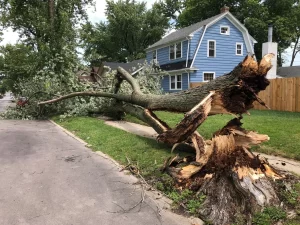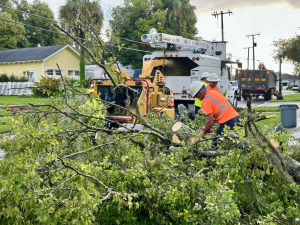Hurricanes are among nature’s most destructive forces, leaving behind trails of devastation that can take weeks or even months to clean up. From downed power lines and flooding to fallen trees and structural damage, the aftermath of a hurricane can be overwhelming. While it’s impossible to prevent a hurricane from striking, having a well-thought-out cleanup plan can make a significant difference in how quickly and safely you can recover. Whether you’re a homeowner, a property manager, or part of a community organization, understanding the key elements of a hurricane damage cleanup plan is essential.
Assessing the Aftermath
 The first step in any cleanup plan begins after the storm has passed and it is deemed safe to go outside. It’s crucial to assess the damage with a clear and methodical approach. Start by checking for any immediate hazards such as gas leaks, electrical issues, or unstable structures. If there are downed power lines or the smell of gas, it is best to contact emergency services before proceeding. Prioritize personal safety by wearing protective gear such as gloves, boots, and masks, especially when dealing with contaminated floodwaters or debris.
The first step in any cleanup plan begins after the storm has passed and it is deemed safe to go outside. It’s crucial to assess the damage with a clear and methodical approach. Start by checking for any immediate hazards such as gas leaks, electrical issues, or unstable structures. If there are downed power lines or the smell of gas, it is best to contact emergency services before proceeding. Prioritize personal safety by wearing protective gear such as gloves, boots, and masks, especially when dealing with contaminated floodwaters or debris.
Take photographs or videos of the damage before starting any cleanup activities. These visual records will be invaluable for insurance claims, disaster relief assistance, and long-term repair planning. Having a complete inventory of damage also helps in communicating with contractors and emergency services. Check This Out for additional tips on how to safely and effectively navigate post-storm cleanup.
Coordinating Cleanup Efforts
Once the initial assessment is done, it’s time to start organizing the cleanup process. If you’re in a residential area, reach out to neighbors and local volunteers to coordinate efforts. Many hands can make light work, especially when clearing large debris like fallen trees or furniture ruined by floodwater. In rural or less-populated areas, contacting local government or community organizations for assistance may be necessary.
It’s also important to understand which tasks can be managed personally and which require professional help. For example, cleaning out a flooded basement or handling mild roof damage may be possible for a homeowner with basic tools. However, mold remediation, electrical repairs, or demolition should always be handled by certified professionals to prevent injury and ensure the work is done safely.
Handling Waste and Debris
Hurricane damage often produces large amounts of waste, including building materials, spoiled food, personal belongings, and yard debris. It’s essential to separate waste into categories such as organic waste, hazardous materials, and general debris. Not only does this make disposal easier, but many municipalities have specific guidelines and schedules for different types of waste collection after a storm.
Check with local waste management services to understand how and when items will be picked up. In some cases, special permits may be required for large-scale disposal or the use of rented dumpsters. Avoid burning debris unless local authorities specifically permit it, as it may pose additional fire risks or violate air quality regulations.
Preventing Further Damage
During the cleanup process, take steps to prevent further damage to your property. Tarping over damaged roofs, boarding up broken windows, and removing standing water are all essential tasks that can minimize additional destruction from the elements or pests. The quicker you can secure your property, the easier the eventual recovery will be.
Keep in mind that mold can begin to grow within 24 to 48 hours in damp environments. Use fans, dehumidifiers, and proper ventilation to dry out affected areas quickly. If mold growth is already visible or extensive, it is highly recommended to bring in professional services, as improper handling can spread spores and worsen health risks.
Documenting for Recovery and Insurance
 One of the most vital yet often overlooked parts of hurricane damage cleanup is thorough documentation. Beyond the initial photos and videos, keep a detailed record of all cleanup activities, including receipts for supplies, hired services, and any temporary accommodations. This documentation will support your insurance claims and can also help you apply for disaster relief from government or nonprofit agencies.
One of the most vital yet often overlooked parts of hurricane damage cleanup is thorough documentation. Beyond the initial photos and videos, keep a detailed record of all cleanup activities, including receipts for supplies, hired services, and any temporary accommodations. This documentation will support your insurance claims and can also help you apply for disaster relief from government or nonprofit agencies.
Stay in regular communication with your insurance provider throughout the process. Understand what is covered under your policy and follow their guidelines carefully when making repairs or hiring services. In some cases, making unauthorized repairs could impact your reimbursement eligibility.
Emotional and Community Support
Cleanup is not just a physical process; it’s an emotional journey as well. Seeing your home or neighborhood damaged can be distressing, and the stress of recovery can take a toll on your mental health. It’s important to take breaks, stay connected with loved ones, and seek emotional support when needed.
Community support can also be a powerful tool. Local organizations, religious groups, and government agencies often provide resources like food, shelter, and volunteers. Don’t hesitate to reach out, and be open to offering help if you are able. Collective resilience is one of the strongest assets in disaster recovery.